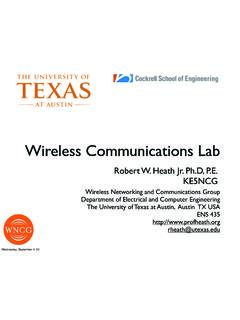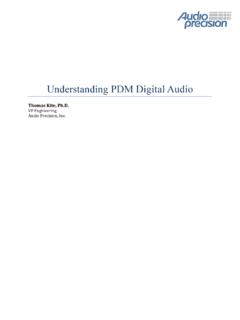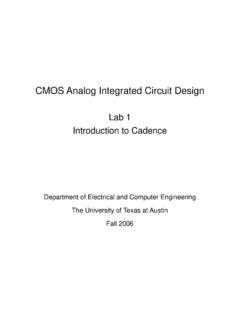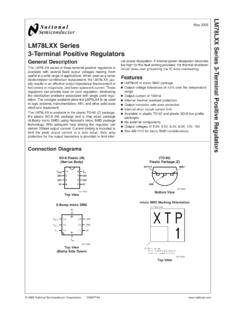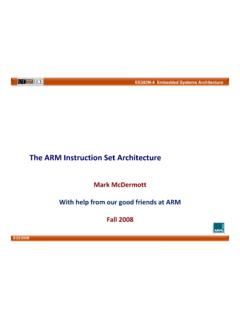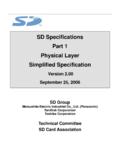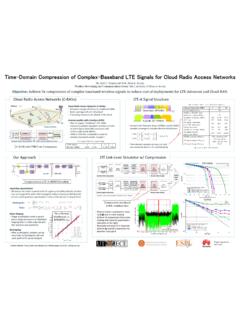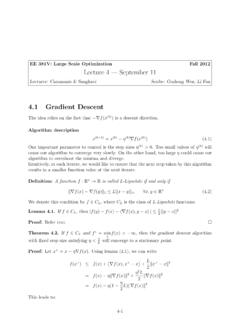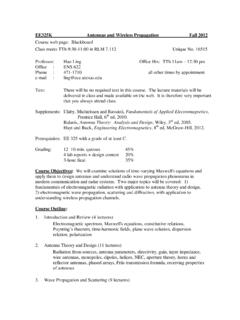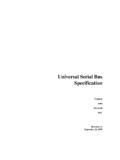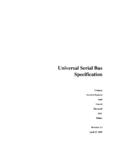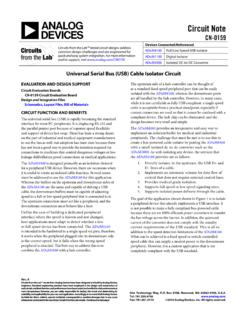Transcription of 14.7. Universal Serial Bus (USB) - University of …
1 Real-time Operating Systems Lecture by Jonathan W. Valvano Universal Serial Bus (USB) General References USB References FifoWriteMicrophoneAmpADCW indowsUSBstackADCyourapplicationOCISRS oundVoltage0 to 5V0 to Old Lab Data-flow graph of the digital scope and spectrum analyzer. Specifications Short distance (typically less than 4 meters) USB supports three speeds. High Speed - 480 Mbits/s Full Speed - 12 Mbits/s Low Speed - One host per bus (at a time) all transactions and scheduling bandwidth Token-based protocol Tiered star topology (Host-centered) Hub provides power Monitors power Switching off a device drawing too much current Filter out high speed and full speed transactions 7-bit address, up to 127 devices can be connected Host loads and unloads drives automatically Real-time Operating Systems Lecture by Jonathan W.
2 Valvano HostHub1 Hub2devicedeviceRoot HubdevicedevicedevicedevicedeviceHub3dev icedevice Figure USB network topology. 1234 USB Type A1234 USB Type B Figure USB connectors. Pin Number Color Function 1 Red VBUS (5 V) 2 White D- 3 Green D+ 4 Black Ground Table USB signals. The D+ and D- are twisted pair differential data Non Return to Zero Invert (NRZI) encoding 1 is represented by no change in level 0 is represented by a change in level String of zeros causes the NRZI data to toggle each bit time String of ones causes long periods with no transitions in the data Bit stuffing ensures transitions to which the receiver can synchronize 0 inserted after 6 consecutive 1 s 1 inserted after 6 consecutive 0 s 0000000010111111 IdleIdleDataNRZI Real-time Operating Systems Lecture by Jonathan W.
3 Valvano The USB architecture comprehends four basic types of data transfers: Control Transfers: Used to configure a device Bulk Data Transfers: Large quantities and wide latitude in constraints. Interrupt Data Transfers: Used for timely but reliable delivery of data. Isochronous Data Transfers: Prenegotiated bandwidth Prenegotiated latency Streaming real time transfers Audio or video applications Stream pipe Unidirectional 5%+ +D-D+D-15k 5%15k 5% 5%+ +D-D+D-15k 5%15k 5% Figure Pull-up resistors on USB devices signal specify the speed. Each USB transaction consists of three packets Token Packet (header), Optional Data Packet, (information) and Status Packet (acknowledge) SyncToken PacketADDR ENDP CRC5 PIDEOPDataData PacketSyncCRC16 PIDEOPSyncHandshake PacketPID EOPF rame NumberStart of FrameSyncCRC5 PIDEOP Figure USB packet types.
4 Real-time Operating Systems Lecture by Jonathan W. Valvano USB functions provide a capability Printer, Thumb Drive, Scanner, Modem or your 9S12. Endpoints are sources or sinks of data (buffers within the device) Host can send data to an endpoint Device puts data in endpoint, but it is not transferred until host requests it HostUSB(Addr,Endpoint,Direction)DeviceAd dr=2EP0 InEP0 OutEP1 InEP1 OutFunctionDeviceAddr=3EP0 InEP0 OutEP1 InEP1 In Figure USB data flow model. pipe is a logical connection between the host and endpoint(s). how much bandwidth what transfer type (Control, Bulk, Iso or Interrupt) direction of data flow maximum packet/buffer sizes Stream Pipes can be used send unformatted data. Data flows sequentially pre-defined direction, either in or out.
5 Bulk, isochronous and interrupt transfer types controlled by the host or device Message Pipes have a defined USB format host-controlled Data is then transferred in the desired direction support control transfers. Real-time Operating Systems Lecture by Jonathan W. Valvano USB-to-SerialConverterUSBPortUSBdriverCO MdriverPersonal ComputerUserProgramSCIdriverEmbedded SystemUserProgramSCIPortUSBUSBPortUSBdri verPersonal ComputerUserProgramEmbedded SystemUserProgramUSBP arallelInterfaceModuleI/OPort Figure Modular approach to USB interfacing. Modular USB interface USB-to- Serial converters IOGear Inc. Wyse Technology D-Link Corporation Computer Peripheral Sys, Inc.
6 Jo-Dan International, Inc. USB parallel interface module. send and receive data using parallel handshake protocols Include a USB-enabled interface and receiver/transmit FIFO buffers more flexible than the Serial cable method, the microcontroller module can be tailored USB drivers can be tailored burn PID and VID numbers into EEPROM. data is unformatted does not implement high bandwidth bulk transfers does not negotiate for real-time bandwidth with isochronous data transfers. Companies that make these modules include Future Tech. Devices Inter. Ltd. ActiveWire, Inc. DLP Design, Inc. Elexol Pty Ltd.
7 Real-time Operating Systems Lecture by Jonathan W. Valvano Integrated USB interface LM3S5651 Microchip PIC18F2455 FTDI FT245BM Freescale 9S12UF32 STM32F103 Real-time Operating Systems Lecture by Jonathan W. Valvano Similarities of USB and CAN Local wired network Serial Half-duplex Differential pair, voltage encoded Microcontroller hardware support (built-in I/O functions) Short distances (same box, same room) Bit stuffing Differences between USB and CAN CAN is distributed, USB is host-controller USB bandwidth is higher CAN can have more nodes USB is powered, CAN is not powered USB has negotiated speed, CAN is fixed speed USB is addressed by destination, CAN has data types Real-time Operating Systems Lecture by Jonathan W.
8 Valvano USB typically used to connect microcontroller to PC/Mac
